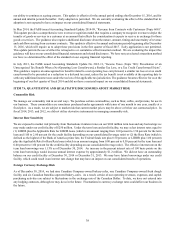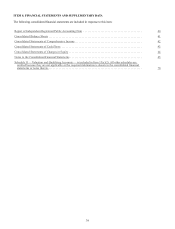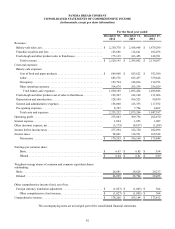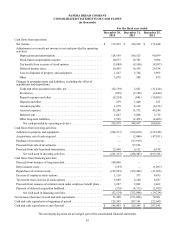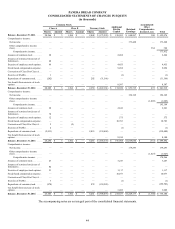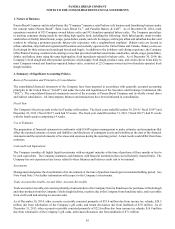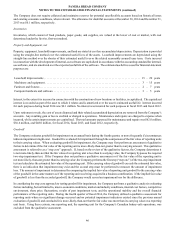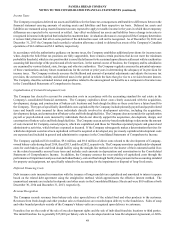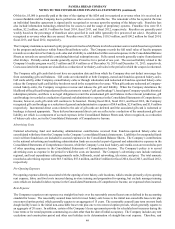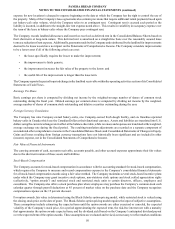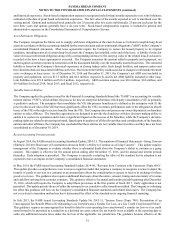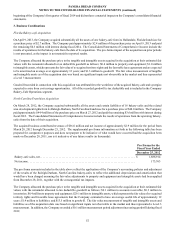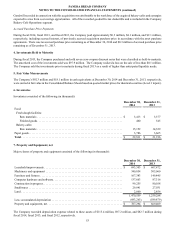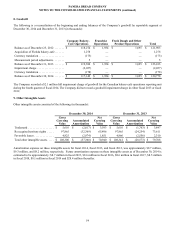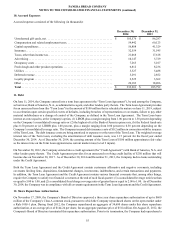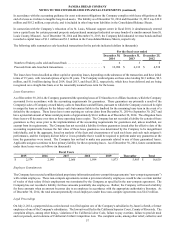Panera Bread 2014 Annual Report Download - page 59
Download and view the complete annual report
Please find page 59 of the 2014 Panera Bread annual report below. You can navigate through the pages in the report by either clicking on the pages listed below, or by using the keyword search tool below to find specific information within the annual report.PANERA BREAD COMPANY
NOTES TO THE CONSOLIDATED FINANCIAL STATEMENTS (continued)
47
In considering the step one approach to testing goodwill for impairment, the Company utilized a quantitative assessment to test
goodwill for impairment for the Canadian reporting unit during the fourth quarter of fiscal 2014. The fair value of a reporting
unit is the price a willing buyer would pay for the reporting unit and is estimated using a discounted cash flow model. The
Company's discounted cash flow estimate was based upon, among other things, certain assumptions about expected future operating
performance, such as revenue growth rates, operating margins, risk-adjusted discount rates, and future economic and market
conditions. The Company determined the carrying value of the Canadian reporting unit exceeded its fair value and thus step two
of the goodwill impairment test was completed. The step two analysis indicated the entire balance of goodwill for the Canadian
reporting unit was impaired and the Company recorded a full goodwill impairment charge of $2.1 million. This charge was
recorded in other (income) expense, net in the Consolidated Statements of Comprehensive Income.
Other Intangible Assets, net
Other intangible assets, net consist primarily of favorable lease agreements, re-acquired territory rights, and trademarks. The
Company amortizes the fair value of favorable lease agreements over the remaining related lease terms at the time of the acquisition,
which ranged from approximately one year to 17 years as of December 30, 2014. The fair value of re-acquired territory rights
was based on the present value of the acquired bakery-cafe cash flows. The Company amortizes the fair value of re-acquired
territory rights over the remaining contractual terms of the re-acquired territory rights at the time of the acquisition, which ranged
from approximately five years to 20 years as of December 30, 2014. The fair value of trademarks is amortized over their estimated
useful life of 22 years.
The Company reviews intangible assets with finite lives for impairment when events or circumstances indicate these assets might
be impaired. When warranted, the Company tests intangible assets with finite lives for impairment using historical cash flows
and other relevant facts and circumstances as the primary basis for an estimate of future cash flows. There were no other intangible
asset impairment charges recorded during fiscal 2014, fiscal 2013, and fiscal 2012. There can be no assurance that future intangible
asset impairment tests will not result in a charge to earnings.
Impairment of Long-Lived Assets
The Company evaluates whether events and circumstances have occurred that indicate the remaining estimated useful life of long-
lived assets may warrant revision or that the remaining balance of an asset may not be recoverable. The Company compares
anticipated undiscounted cash flows from the related long-lived assets of a bakery-cafe or fresh dough facility with their respective
carrying values to determine if the long-lived assets are recoverable. If the sum of the anticipated undiscounted cash flows for
the long-lived assets is less than their carrying value, an impairment loss is recognized for the difference between the anticipated
discounted cash flows, which approximates fair value, and the carrying value of the long-lived assets. In performing this analysis,
management estimates cash flows based upon, among other things, certain assumptions about expected future operating
performance, such as revenue growth rates, operating margins, risk-adjusted discount rates, and future economic and market
conditions. Estimates of cash flow may differ from actual cash flow due to, among other things, economic conditions, changes
to the Company's business model or changes in operating performance. The long-term financial forecasts that management utilizes
represent the best estimate that management has at this time and management believes that the underlying assumptions are
reasonable.
The Company recognized impairment losses of $0.9 million, $0.8 million, and $0.3 million during fiscal 2014, fiscal 2013, and
fiscal 2012, respectively, related to distinct, underperforming Company-owned bakery-cafes. These losses were recorded in other
operating expenses in the Consolidated Statements of Comprehensive Income.
Self-Insurance Reserves
The Company is self-insured for a significant portion of its workers’ compensation, group health, and general, auto, and property
liability insurance with varying deductibles of as much as $0.8 million for individual claims, depending on the type of claim. The
Company also purchases aggregate stop-loss and/or layers of loss insurance in many categories of loss. The Company utilizes
third party actuarial experts’ estimates of expected losses based on statistical analyses of historical industry data, as well as its
own estimates based on the Company’s actual historical data to determine required self-insurance reserves. The assumptions are
closely reviewed, monitored, and adjusted when warranted by changing circumstances. The estimated accruals for these liabilities
could be affected if actual experience related to the number of claims and cost per claim differs from these assumptions and
historical trends. Based on information known at December 30, 2014, the Company believes it has provided adequate reserves
for its self-insurance exposure. As of December 30, 2014 and December 31, 2013, self-insurance reserves were $32.6 million and
$31.5 million, respectively, and were included in accrued expenses in the Consolidated Balance Sheets. The total amounts expensed
for self-insurance were $50.7 million, $46.9 million, and $41.8 million for fiscal 2014, fiscal 2013, and fiscal 2012, respectively.



